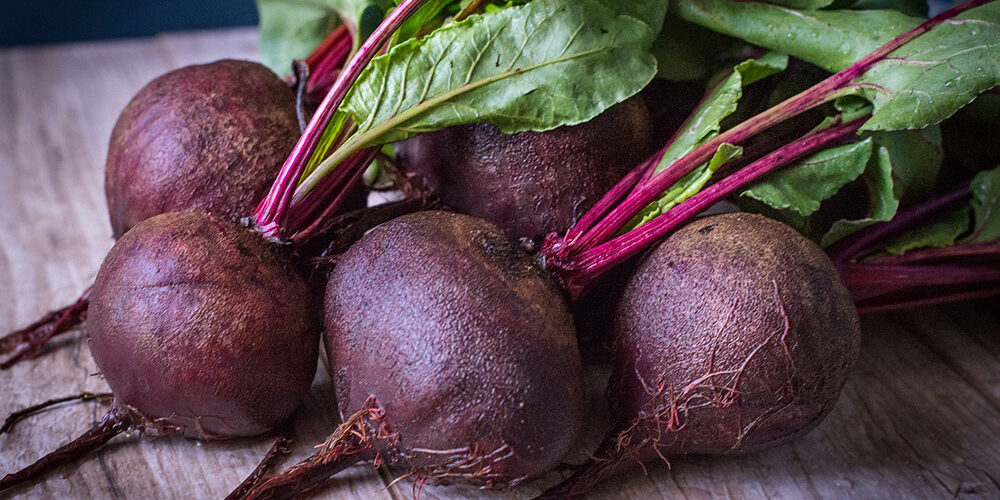Growing Beets

A staple in our garden, beets grow easily and you won’t have to wait long until harvesting their tasty roots. And you can eat their green tops, too, so they’re a dual-purpose crop. Learn all you need to know about growing beets—from planting to harvest!
Beets or “beet roots” are a colorful, cool-season crop that is easy to grow from seed in well-prepared soil—and grows quickly in bright sun.
They are a great choice for northern gardeners because they can survive frost and near-freezing temperatures.
If you are a beginner, look for bolt-resistant varieties, which have less of a chance of bolting (maturing too quickly) in warm weather. There are many different varieties of beets, showcasing deep red, yellow, white, or striped roots of different shapes.
Beet roots can be harvested from the time they’re about the size of a golf ball to the size of a tennis ball; larger roots may be tough and woody. Plus, beet greens have a delicious and distinctive flavor and hold even more nutrition than the roots!
Planting
When to plant beets
- Start your first round of beets in early spring, as soon as the soil is workable. Make successive plantings every 2 to 3 weeks until mid-summer.
- Successive plantings are possible as long as daytime temperatures don’t exceed 75°F.
- In soil that’s at least 50°F (10°C), germination takes place in 5 to 8 days. In soil colder than 50°F, germination may take 2 to 3 weeks.
- Winter crops are a definite possibility in Zone 9 and warmer. Plant beets in early to late fall for a winter harvest.
Choosing and preparing a planting site
- Plant beets in full sun.
- Beets prefer well-prepared, fertile soil but will also tolerate average to low soil fertility.
- To allow beet roots to develop properly, soil should be free of rocks and other obstacles.
- Soil pH between 6.0 and 7.0 is best and slightly alkaline (7.0+) soils can be tolerated. Beets do not tolerate soil with a low pH (below 6.0).
- If you fertilize, go easy on nitrogen; excess will cause an abundance of greens but tiny bulbs beneath the soil. Learn more about soil amendments and preparing soil for planting.
How to plant beets
- We prefer to sow beets directly in the garden so that we don’t have to disturb their roots, though beets—unlike many root crops—do generally tolerate being transplanted while still young. However, since they are cold tolerant, beets typically have no trouble being started outdoors.
- Sow seeds ½-inch deep and 1 to 2 inches apart in rows that are about 1 foot apart. After sowing, cover the seeds with a thin layer of soil.
- Each wrinkled beet “seed” is actually a cluster of 2 to 4 seeds, so you will need to thin the young plants to 3 to 4 inches apart once the greens get to be about 4 inches tall.
- Make sure soil remains moist for optimal germination. Soak seeds for 24 hours prior to planting to speed up germination.
Care
How to grow beets
- Thinning is necessary, as you may get more than one seedling out of each seed. When the tops are a 4 to 5 inches tall, thin seedlings to 3 to 4 inches apart. Pinch or cut off the leaves. Pulling them out of the ground may disturb the roots of nearby seedlings.
- Mulch and then water regularly with about 1 inch per week. Beets need to maintain plenty of moisture.
- Weed as needed but be gentle; beets have shallow roots that are easily disturbed.
Pests/Diseases
- Flea Beetles
- Leaf Miners
- Leaf spot
- Cercospora
- Leafhoppers
- Mosaic Virus
Harvest/Storage
How to harvest beets
- Days to maturity tend to be between 55 and 70 for most varieties. In other words, plan to harvest beets about 2 months after planting.
- Harvest roots when golf ball-size or larger; very large roots may be tough and woody.
- Loosen the soil around the beet and gently pull it from the earth.
- Harvest the beet greens at almost any time, beginning when thinning seedlings. Take one or two mature leaves per plant, until leaf blades are more than 6 inches tall and become tough. (Roots will not fully form without greens, so leaving some is necessary for proper development.)
How to store beets
- Fresh beets can be stored in the refrigerator for 5 to 7 days.
- Tip: Clipping the tops off beets will keep them fresher for longer. Leave about 1 inch of stem on each beet, and store the greens separately.
- For long-term root cellar storage, make sure you brush off any soil clinging to the roots, then bury them in layers (but not touching) surrounded by dry sand or sawdust.
- Store in a cool, dry place. An unheated closet might do, or put them in a cooler in your basement. Read more about a new way to store beets in the root cellar.
- Sprouting is a sign of poor storage and leads to decay.
- Beets can be frozen, canned, and pickled, too!
Recommended Varieties
Beets come in quite a few shapes and a rainbow of colors. Deep red is typical, but yellow and white varieties are also available, as are red-white ringed ones (pictured above)!
- ‘Detroit Dark Red’: Sturdy, traditional variety. Round, red root.
- ‘Formanova’: Long, cylindrical beets that grow in the same fashion as carrots. Excellent for canning.
- ‘Chioggia’: red skin; when sliced open, reveals red and white concentric rings
- Yellow varieties include ‘Bolder’ or ‘Touchstone Gold’
- White varieties include ‘Avalanche’ or Dutch heirloom ‘Albino’
Website: www.almanac.com